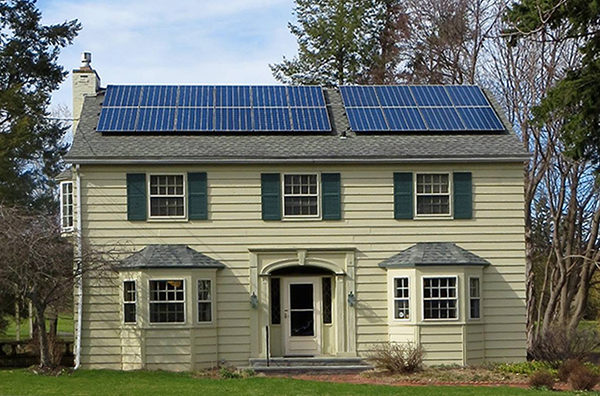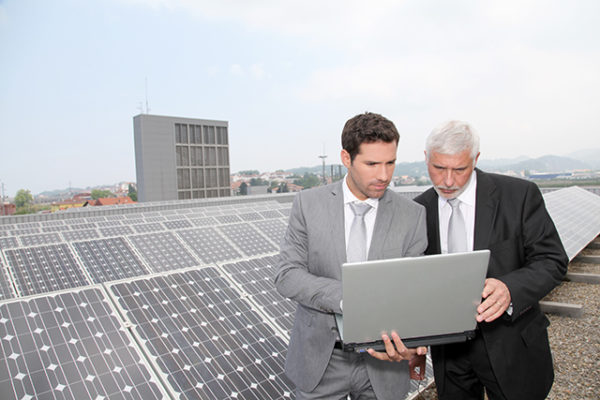
Solar: it’s clean, it’s plentiful, it can’t be used up or spilled and it can be produced where it is used!
It’s easier than ever to go solar!
Even Syracuse, NY, America’s snowiest city, has more days of sun for solar electric power than Germany, the world leader in solar!
With grants & tax credits, owning equipment that converts sunlight to electricity to produce your own electricity makes sense for homeowners & businesses, who in many cases can sell their excess power back to the electric company. But you don’t have to be wealthy or even to own a home, to use solar energy, because affordable leasing, sharing and “subscribing” arrangements are widely available in many parts of the United States.!

Can solar power increase the value of your home, save you money and help the planet? YES! Homes with photovoltaic (PV) equipment that turns light into electricity, sold 20% faster and for 17% more than the equivalent non-solar homes in surveyed California subdivisions ten years ago. By the end of 2014, when more than half a million U.S. homes had PV, the most comprehensive study of solar’s impact on home prices all across the USA, in varying markets and with all styles of homes, showed that home buyers consistently were willing to pay more for homes with host-owned solar photovoltaic (PV) energy systems than homes without.
Can you “go solar” even if you don’t own a home, or a roof? Yes! Read on!
There are 4 different ways you can go solar.
- On-site ownership of equipment. You can buy a solar photovoltaic system to be installed on your property, either on your roof or a ground mounted stand. You will own it entirely, and you will receive the tax benefits and incentives directly. If your state allows net metering, you will be able to sell any excess power you produce back to the utility company for a credit you can use later. By installing the correct amount of capacity, you should be able to supply your own year’s worth of electricity and not have to purchase any from a utility company.
- On-site leasing of equipment. You can lease a solar photovoltaic system to be installed on your property with little or no up front expense. It is a lot like renting the equipment, and it’s done with either a lease or a Power Purchase Agreement (PPA). The equipment will be owned and maintained by someone else, and you will pay the owner of the equipment for the power you use, usually at a predetermined rate that is less than you’d pay for utility generated power, for a specific term of time, typically 20 years. The owner of the equipment receives all tax benefits.

- Off-site ownership of equipment and site. You can buy a solar photovoltaic system to be installed in a community based solar project, that’s not part of the property you live on, with shared ownership and shared net metering, such as a solar farm. You will own your equipment entirely, and you will receive the tax benefits and incentives directly. In states with net metering, you will bank kilowatt hours you produce that exceed your immediate needs, and use them at a later time. You can sell your PV community solar investment to somebody else, if and when you want.
- Purchase of solar electricity produced elsewhere. You can buy solar power from an energy provider who produces or purchases solar generated power and resells it. That can be a big utility company like you’re used to working with already. Or it could be a solar energy company, someplace in a nearby town or county, that builds and installs solar for homes and businesses, that has decided to expand into offering solar created electricity to people who select them as their electricity producer. You have no costs or tax advantages of ownership, but you can be satisfied that all the electricity you use comes from one renewable source: the sun.
Can solar power enhance the profitability of your business? YES!

Solar powers businesses profitably
Plenty of smart businesses across America are using their properties to generate solar power. Walmart leads the way, with more solar capacity than 35 states combined. Some businesses have installed so much solar that they’ve met their own needs and then some. For example, Apple Inc. plans to sell excess electricity generated by solar panels on the roof of its new headquarters in Cupertino, California. But it’s not just big business that’s turning to solar. Increasingly, small to mid-sized businesses and farmers are looking at a value proposition that considers the Federal and state incentives, increased efficiencies of products, economies of scale, predictable cost for electricity, plus opportunity for reduced operating costs.




